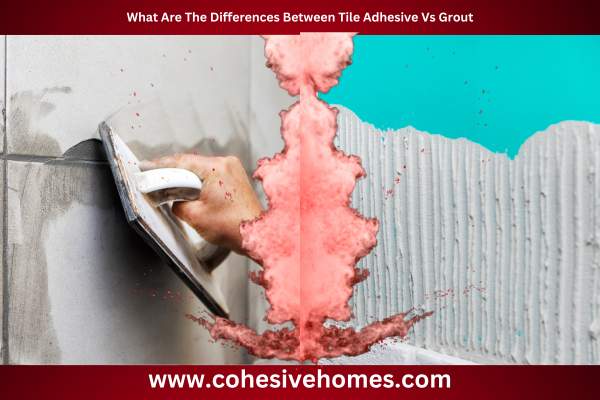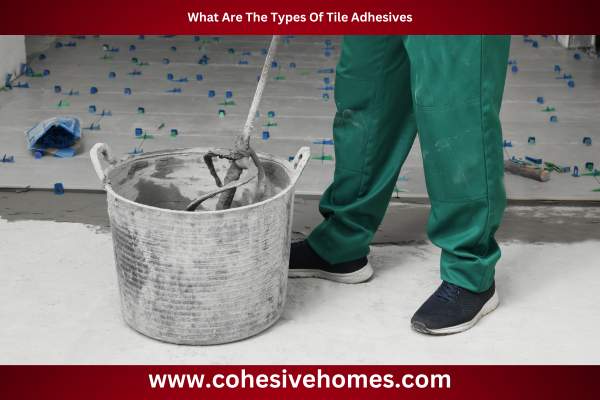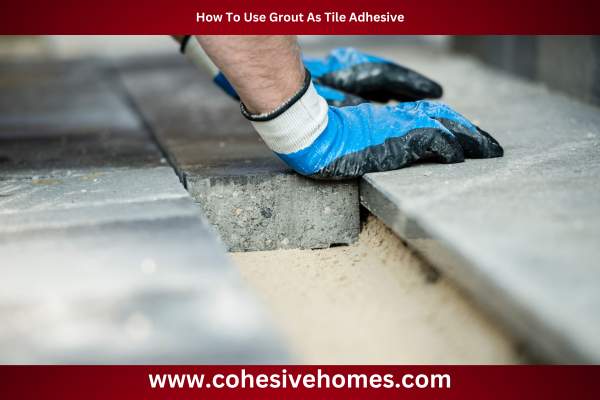When tiling your house, you will be using different materials. Tile adhesive and grout are two common products that you can use to keep the tile in place.
Imagine that you are planning to redesign the kitchen. Retiling will provide a new look to the place.
When you check the essential goods, you notice that you don’t have the tile adhesive.
Can you use the grout as an alternative to tile adhesive without running back to the store?
Yes, you can use grout as a tile adhesive, but it is not recommended. The adhesive is used to stick the tile firmly to the surface.
In contrast, grout will help to fill the gaps after laying the tiles. Hence, using them for their intended purposes is the most suitable option.
The blog will provide some essential facts about using grout as a tile adhesive.
What Are Differences Between Tile Adhesive Vs Grout

Tile adhesive and grout are two different products.
When tiling your home, it is necessary to understand these products.
Tile Adhesive
The main purpose of using tile adhesive is to bond the tile to the surface.
Suppose a piece of tile is cracked or broken; you can glue it using this adhesive. Hence, this type of glue will help keep them in place.
Grout
Grout, on the other hand, is used when filling the space between the laid tiles.
This cement-based product will help to produce a finished look.
Grout will also prevent the growth of bacteria, mold, and other germs. You can use colored grout to match it with the color of your tiles.
What Are The Types Of Tile Grout

There are different types of tile grout. The following are some popular types:
Unsanded Grout
The unsanded grout will be an excellent option to fill the gaps in the wall tiles.
There is no sand mixing involved when using this product. Also, it will produce thin grout lines.
Sanded Grout
Sanded grout is best for filling large gaps between the tiles. The fine sand present in this product will ensure durability.
Epoxy Grout
Hence, this grout will be the most suitable option when tiling wet surfaces.
What Are The Types Of Tile Adhesives

Similar to grout, there are different options available in tile adhesive.
Tile Mastic
Using tile mastic is extremely simple and easy to clean. Although this adhesive is a good option, it is unsuitable for glass tiling.
Thinset Mortar
Thinset mortar is a cement-based powdered adhesive.
You mix this powder to create a sticky adhesive that will help strongly bond the tile to its surface on the other side. This adhesive is prone to cracking.
Epoxy Mortar
Epoxy adhesive is resistant to chemicals and grease. This is a waterproof tile adhesive mortar and will create a firm bond.
Can I Use Grout To Hold Tiles Together?
The comparison between grout and tile adhesive might have helped you understand the difference between them.
Although these two products serve different purposes, most people wonder if grout can be used as a tile adhesive.
Yes, you can use grout to bond the tiles to the surface.
Although grout can help stick tiles together, using it as an adhesive is not recommended.
So if you want to ensure durability and a professional finish, it is better to use a suitable tile adhesive.
How To Use Grout As A Tile Adhesive

Like the tile adhesive, you will have to apply the grout to the surface. Then lay the tile on top and allow it to dry. This way, you can use grout as an alternative for tile adhesive.
It is better to use grout when replacing a broken piece of tile.
Since grout is not a good adhesive to cover the whole surface, it is better to refrain from using it as an adhesive.
What Are The Benefits Of Using Grout As A Tile Adhesive
- Using grout as an adhesive helps to repair or tile a small area. Hence, you can use grout to fix any broken tile.
- You can use the leftover grout as tile adhesive rather than throwing it in the trash.
- You can use grout as an alternative for tile adhesive. Also, this product is cheaper compared to adhesives.
- Grout facilitates tile installation.
- Although sticking tiles together with grout is a temporary solution, once the grout dries, it will be durable for a few years.
Disadvantages Of Using Grout As A Tile Adhesive
Many professionals do not recommend using grout as a tile adhesive for the following reasons:
- Grout will not work perfectly as the adhesive, so you cannot guarantee durability.
- It will be difficult to clean if you make a mistake during the application process.
- If you are using an expensive grout to bond the tiles, then this can add more expenses to the project.
- This product is susceptible to mildew and mold growth.
- Over time, grout can absorb stains and dirt as it is porous.
What Happens If The Tile Aren’t Grouted?

Imagine requesting a professional tiler to install tiles without grouting and instead using the grout to bond the tiles to the surface.
Although you can tile the surface that way, most professionals will try to explain why tile grouting is mandatory.
The main drawbacks are given below:
- When tiling unidentical tiles, you will witness an unalignment. This is because you skipped the grouting process.
- Over time, dirt can get beneath the tiles. This may cause damage and affect durability.
- Breakage can occur due to movement.
Hence, grout the tile and use a tile adhesive to ensure durability.
Conclusion
Tile grout and tile adhesive are there to serve different purposes. Hence, you must use these products for their intended purposes to obtain the best results.
Therefore, depending on the tile type and size, you can choose the suitable grout and adhesive.
This will help to get a professional finish and prevent frequent repairs. Finally, grout can be used as a tile adhesive, but it is highly discouraged!
FAQs
Can Tile Grout Bond The Tiles To The Surface?
Yes, grout will help bond the tiles to the surface.
In contrast, the primary purpose of grout is to fill the gaps and bond the tiles together.
How Long Should I Leave The Grout Before Wiping?
You must leave it for around 15 to 30 minutes to set.
Then you can wipe away the excess grout. It is encouraged to clean it as soon as possible after setting. Over time, the grout will dry and become hard.
Can I Grout The Tiles Sooner After Laying Them?
No, you must wait at least 24 to 48 hours.
